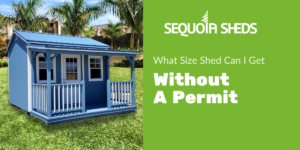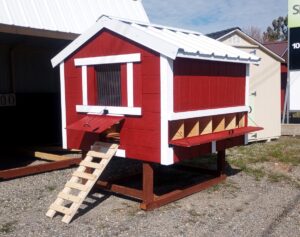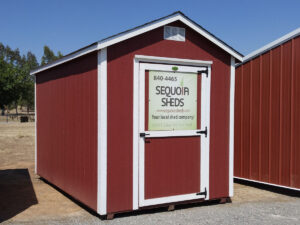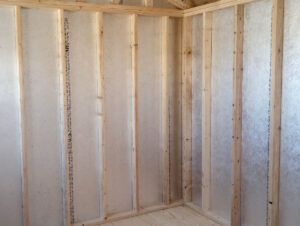You’d like to buy a shed. You know where you want to put it, but you’d like to know: “What do I need to do to the site so it’s ready for a shed?”
First, a few preliminary facts. Ideally, there will be at least 18” of room on all four sides of the shed, so we can work on all four sides of it. Let us know if your scenario is different from that. Also, we will need enough height for the shed to fit comfortably under any tree branches or overhead wires.
Now, let’s talk about the spot on the ground where your shed will sit. There are three types of shed sites: dirt, gravel, and concrete/paved sites.
Preparing a Dirt Site for a Shed
Some of our customers ask if we’ll even install a shed on dirt. Yes, we will! There are some things to keep in mind, though, for dirt sites. The first thing is that the dirt must be fairly level. We ask that any shed site be within 6 inches of level if possible. If it is more sloped than that, please tell us, and we can advise you what to do.
Another thing to consider (and this is true for gravel sites as well) is whether water will pool under the shed. You don’t want that. Any water that goes under the shed should be able to run out again. So try to avoid low spots within the shed footprint.
Another thing to think about is how soft the dirt is, and whether the shed will settle after it’s placed. We place our shed runners on concrete blocks. Those concrete blocks are what hold up the shed. There are typically around nine blocks under a 10×12 shed. Each block will hold an average of 100-200 pounds when the shed is empty. When it’s full of several thousand pounds of stuff, that weight will at least double. Where the ground is naturally soft, or where water may flood under the shed after it is placed, those pads will tend to sink into the ground over time under the weight of the shed and its contents. This is especially an issue if the shed has a lot of weight in it.
If the shed settles unevenly, with one corner sinking in more than another, the first thing that will happen is the door will jam in its opening. That is often your first clue that the shed has settled. Sequoia Sheds does not perform free service calls to re-level sheds that have settled. But we do want to give you the information you need to hopefully prevent it from happening in the first place.
How to prevent this? If water under the shed or soft soil is a problem, it’s best to build the site up with gravel. A gravel pad will help with both the water problem and with the soft dirt problem.
Preparing a Gravel Site for a Shed
Gravel pads have several advantages over dirt pads. We’ve already talked about the problem of the shed settling into the ground. Gravel helps with that. But gravel also helps the area under your shed stay drained of moisture. It also decreases your chances of having gopher mounds under your shed, if you have a problem with gophers. And a gravel apron around your shed will keep the water running off your roof from splashing up your siding with mud. This is a real problem, and it isn’t good for your siding!
The best type of gravel we’ve worked with so far is road base. This gravel is a mix of gravel and fine particles. When wetted down and compacted, it forms a very hard, smooth surface that is excellent for placing a shed. Three-quarter inch gravel will work well too.
With all gravel pads, it’s best if you can compact the gravel or drive over it with a piece of equipment, to help the gravel settle. Even if you’re not able to do this, though, a gravel pad will definitely reduce the problem of a shed sinking into soft soil.
Make the gravel pad two feet wider and two feet longer than the shed you plan to get, so that there’s a one foot apron on every side of the shed. When rainwater runs off the roof, the gravel will catch it and prevent dirt from splashing up against the side of your shed.
Thickness? Three or four inches thick is a good minimum.
Preparing a Concrete Slab for a Shed
Any concrete slab that is at least as big as the footprint of the shed will make an excellent foundation for the shed to sit on. If you plan to purchase a pre-built shed, it will come with a wooden floor and runners. Those runners will sit on your slab.
If you want to pour a new slab and use it as a floor for your shed, instead of having a wooden floor, then here is what you need to know. The slab must be level and square. It should be half an inch less in each dimension than the footprint of the shed will be. If the shed will be a 10’x12’shed, which is 120”x144”, the pad should be 119 1/2”x143 1/2”. This is just to make sure the pad is not too big anywhere. We want our siding to overhang the slab a bit. Also, it’s a good idea to get the surface of the slab at least 6” to 8” higher than the surrounding area. We can work with a 4” slab, but it’s good to get that siding up off the dirt a bit higher than 4”.
You do not need to install anchor bolts in the perimeter of your slab. We prefer to install our own drilled-in anchor bolts as the shed is being built.
Some re-bar or wire mesh to hold the pad together is a good idea. So is a groove or cut in the concrete, one groove in each direction, cutting the slab into four quarters. This groove or cut will control where the concrete cracks as it dries.
If you have a concrete contractor, he may have even better ideas than ours. These are just some ideas we’ve found helpful, that we are passing on to you DIY folks out there.
Sometimes customers have an old existing slab that they would like a shed to be built on. If the slab is an odd size, we may still be able to build a shed to fit it. However, there will be an extra charge for the odd size.
Contact Us If You Have Questions
We’d be more than happy to answer any questions you have about your shed site. Call us at (530) 840-4465, or use the Contact Form on our website to email us. To get a quote for your shed, whether delivered already built or built on-site, use our Quote Request form to get a quote tailored to your needs.
Happy shed site prepping!





